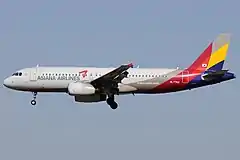Asiana Airlines Flight 162
Asiana Airlines Flight 162 was a regular short-haul international passenger flight from Incheon International Airport near Seoul, South Korea, to Hiroshima Airport in Hiroshima, Japan.[1] On 14 April 2015, the Airbus A320-232 aircraft touched down short of the runway, struck the localizer array, skidded onto the runway on its tail, and spun 120 degrees before finally coming to a rest on the grass, opposite the terminal building. The aircraft suffered substantial damage to the left wing and engine. Of the 82 people aboard, 27 (25 passengers and two crew) were injured, one seriously.[2][3][4]
 HL7762, the aircraft involved, photographed in 2011 | |
| Accident | |
|---|---|
| Date | 14 April 2015 |
| Summary | Descent below final approach path, impact with ground structures |
| Site | Hiroshima Airport, Mihara, Hiroshima, Japan 34.4361°N 132.9194°E |
| Aircraft | |
| Aircraft type | Airbus A320-232 |
| Operator | Asiana Airlines |
| IATA flight No. | OZ162 |
| ICAO flight No. | AAR162 |
| Call sign | ASIANA 162 |
| Registration | HL7762 |
| Flight origin | Incheon International Airport, South Korea |
| Destination | Hiroshima Airport, Japan |
| Occupants | 82 |
| Passengers | 74 |
| Crew | 8 |
| Fatalities | 0 |
| Injuries | 27 |
| Survivors | 82 |
Aircraft and crew
The aircraft involved, an Airbus A320-200 registration HL7762, was delivered new to Asiana Airlines in 2007, making the aircraft seven years old at the time of the accident. The aircraft was written off as a result of the incident,[5][6] making it the 32nd hull loss of an Airbus A320.[1]
The captain was a 47-year-old male who had 8,242 flight hours, including 1,318 hours on the Airbus A320. The first officer was a 35-year-old male who had 1,588 flight hours, with 1,298 of them on the Airbus A320.[7]:15–16 Actual names of the crew were not disclosed.
Accident

The transport ministry’s Osaka Regional Civil Aviation Bureau stated that the crew tried to land the aircraft in darkness and inclement weather without access to an instrument landing system. At this airport, aircraft normally approach from the west because the instrument landing system is installed only at the eastern end of the runway. On this occasion, the pilot was instructed by an air traffic controller to approach from the east due to the wind direction. Bureau officials were reported to have stated that the pilot attempted to land in poor weather with low visibility while using such aids as the lighting near the centre-line of the runway that indicates glide angles (normally used in good weather conditions).[8][9]
Investigation

The Japanese Transportation Safety Board (JTSB) opened an investigation into the accident.[10] Hiroshima Prefecture Prefectural police also launched an investigation on 15 April.[8] South Korean investigators and airline officials traveled to Japan to join the investigation on 15 April.[9]
On 16 April, investigators began debriefing the captain and first officer. One investigator from the JTSB stated that a downdraft during approach may have contributed to the inadequate altitude at the runway threshold.[11] The METAR (weather conditions) for the time did not indicate any unusual weather or wind shear. The weather was low overcast with almost no wind.[10]
Recovered flight data shows that, after autopilot disconnect, the aircraft began a slow and controlled descent below the normal glide slope approach path about 4 km prior to impact.[10] It struck the localizer 325 metres (355 yd) before the runway threshold in a nose-high attitude 148 metres (162 yd) short of the runway, with the main gear making contact with the ground 12 metres (39 ft) further on. After exiting the runway, the aircraft rotated until it came to rest facing the direction it had landed from.[12]
See also
References
- Ranter, Harro (14 April 2015). "ASN Aircraft accident Airbus A320-232 HL7762 Hiroshima International Airport (HIJ)". aviation-safety.net. Aviation Safety Network. Retrieved 16 April 2015.
- "The Aviation Herald". avherald.com. Retrieved 16 April 2015.
- "Asiana Airlines Plane Skids Off Runway In Japan". The Huffington Post. Retrieved 16 April 2015.
- "Asiana plane skids off runway in Japan, leaving 20 injured". The Daily Telegraph (online edition). AFP. 15 April 2015. Retrieved 15 April 2015.
- "Asiana Airlines HL7762 (Airbus A320)". Retrieved 24 April 2015.
- "HL7762 Asiana Airlines Airbus A320-200 – cn 3244". planespotters.net. Retrieved 16 April 2015.
- "AIRCRAFT ACCIDENT INVESTIGATION REPORT ASIANA AIRLINES, INC. AIRBUS A320-200, HL7762 COLLISION WITH THE AERONAUTICAL RADIO NAVIGATION AIDS CAUSED BY UNDERSHOOTING HIROSHIMA AIRPORT AT 20:05 JST, APRIL 14, 2015" (PDF). Japanese Transport Safety Board. 2016-11-18. Retrieved 2020-06-14.
- "Police investigate airliner accident in Hiroshima on suspicion of pilot error". Asahi Shimbun. 15 April 2015. Archived from the original on 2015-04-15. Retrieved 15 April 2015.
- Obe, Mitsuru; Nam, In-Soo (15 April 2015). "Japan, South Korea Probe Asiana Plane's Skid off Runway in Hiroshima". The Wall Street Journal. Retrieved 16 April 2015.
- "The Aviation Herald". avherald.com. Retrieved 16 April 2015.
- "Downdraft may be factor in Asiana jet's botched landing at Hiroshima". Japan Times. 16 April 2015. Retrieved 15 April 2015.
- Kaminski-Morrow, David (13 May 2015). "Crashed Asiana A320 drifted below glidepath in low visibility". Flight Global. Retrieved 17 May 2015.
External links
- Final Report by Japan Transport Safety Board - English translation and Original Japanese version - In case of a conflict in meaning and intepretation between the two, the Japanese report prevails.
- The response from MOLIT to the safety recommendation - Ministry of Land, Infrastructure and Transport (MOLIT)
- "Information on HL7762 from Seoul(Incehon) to Hiroshima." Asiana Airlines.
- "Airbus A320 – Flight OZ 162 –Hiroshima Airport (Japan) – 14 April 2015" (Archive). Bureau d'Enquêtes et d'Analyses pour la Sécurité de l'Aviation Civile.